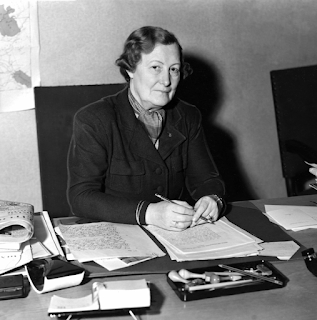Farmer Women's Movement
Olga Bjoner was chairman of the peasant women's movement from 1921 to 1940. In 1921, she started the first peasant women's team. When she left the movement, it had 500 teams and 25,000 members. Bjoner was a sought-after speaker in the 1930s and editor of the women's pages of the peasant press.
When Peder Kolstad formed the Farmers' Party government in 1931, Olga Bjoner was speaking as a minister. In that case, she would become the first female cabinet minister in Norway. When nothing else came of it, it was justified, among other things, by her place of residence, that you could not have both the prime minister and a minister from Østfold in the same government.
Betzy Kjeldsberg was head of the Women's Organisation's committee for dietary fairs, and in May 1936, Olga Bjoner was elected deputy head. The same autumn, she acquired a one-room dormitory in Fagerborgveien 48 in Oslo to make her commuting life easier.
The following spring, she moved to a small flat on the fifth floor in the newly built Bygdø allé 20. With the occupation, she got her wish fulfilled for an apartment on the top, on the ninth floor, when the Englishman in no. 902 fled the country.
In June 1938 she was given a cruise with "Wilhelm Gustloff" to Lisbon and Rome as the first of 200 guests and 800 other passengers. Hitler's sister was also on board: "But she did not attract much interest," wrote Bjoner. "I think the Germans regard their beloved leader as completely isolated from those closest to him (...)He belongs to his people, not his family."
Nasjonal Samling
Bjoner first met Heinrich Himmler at the agricultural fair in Hamburg in 1935. She met him again when she and Bishop Berggrav attended a dinner at Skaugum on 29 January 1941. Terboven was the host and said that Norwegian women had too much to say in politics. Bjoner objected that the women, on the contrary, had too little to say, because otherwise "you wouldn't be sitting here now. They had provided a proper defense, so neither the Germans nor the English had slipped in." This did not soften Terboven's tone, while Himmler, on the other hand, praised Norwegian women in a speech. On 20 May 1941, he landed at Fornebu again, when the first Norwegian SS unit took the oath of allegiance to Hitler and Quisling. At the airport, he was met by, among others, Olga Bjoner.
The trip in 1941 to the Women's Congress in Berlin was the last Olga Bjoner took to Germany. The view she had of women as men's equals was on a collision course with Hitler's, and in Germany she was no longer welcome.
Women's Auxiliary Corps
She formed the Women's Auxiliary Corps (KHK) in 1944. Bjoner, like several other women in the leadership of the NS Women's Organization, disagreed with Hitler's view of women. Where Hitler and German National Socialism emphasized the home as the woman's world, Bjoner believed that women had to be politically active. Bjoner was a type of women's advocate that was not uncommon on the bourgeois side before the Second World War.
The national fraud judgment
In the national betrayal settlement after the Second World War, Olga Bjoner received six years' imprisonment, a compensation claim of NOK 15,000 and ten years' loss of rights. The latter meant that she was not allowed to vote in elections, was not given the opportunity to hold a public position and could not run a business that needed a public licence. The prosecutor submitted a request for 12 years' imprisonment, but this was reduced due to age and illness. She had also spent 720 days in custody. She experienced both being harassed and bullied in Bredtveit prison, which broke her health down. It was not until 11 November 1948 that her son Sigurd was allowed to bring his mother home. By then she had completed her 1,026 days.
After the war
Her autobiography from 1955 is a bitter confrontation with the court settlement after the war. Bjoner himself had a great desire for reconciliation. In Folk og Land, she wrote on 21 March 1952: "We who joined NS can readily admit that during the occupation, great mistakes were made and very unfair in many ways." To her pen pal pastor Eystein Poulsen in Vikersund, she wrote on 18 May 1956: "I must have made mistakes many times during the occupation, a lot could have been solved in a different way, I do not apologize for that, I could have done much more for my unhappy countrymen, but in the main case itself, I stand without remorse." In 1956, the leader of the squad that arrested her in 1945 came and asked for forgiveness, while many of the villagers had turned around and regained the best relationship with the Bjoner family, which made life much easier for her.
In October 1967, her last article was in Folk og Land, under the heading "Hope nevertheless!" In May 1969 she was taken seriously ill to Askim hospital and died on 25 June 1969. She is buried at Hobøl cemetery.





Inga kommentarer:
Skicka en kommentar